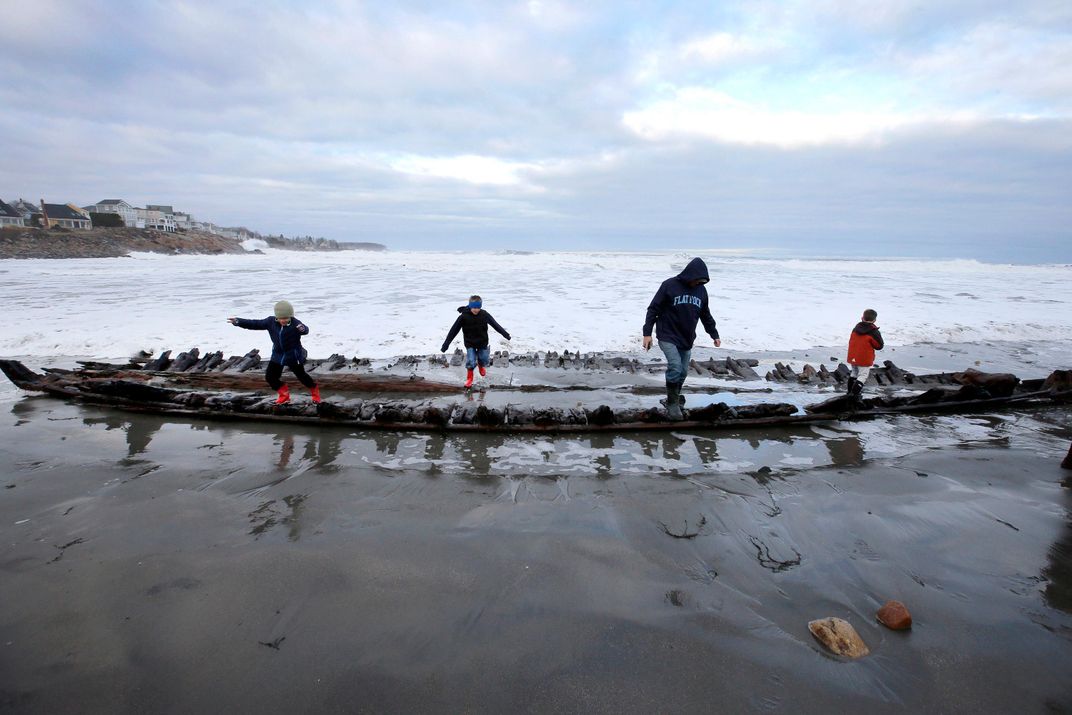Maine Shipwreck Identified as Colonial-Era Cargo Vessel
Storms reveal, then hide, the ship’s sand-covered remains every decade or so
:focal(1399x462:1400x463)/https://tf-cmsv2-smithsonianmag-media.s3.amazonaws.com/filer/af/39/af39a232-fb05-4c98-a4cc-e18cdd22ed07/gettyimages-928555116.jpg)
About two years ago, a nor’easter struck York Beach, Maine, revealing the skeleton of a centuries-old shipwreck beneath the sand. This was far from the first time the mysterious ruin had surfaced, only to disappear again: In fact, the wreck first appeared on the state’s sandy shores in 1958. Now, after decades of anonymity, marine archaeologist Stefan Claesson has found evidence linking the vessel to a colonial-era cargo ship called the Defiance.
Claesson presented his findings to the local Board of Selectmen earlier this month, reports Erin Hayes for Seacoast Online. To identify the wreck, he sent pieces of its hull to the Cornell University Tree-Ring Laboratory, which analyzed the samples to determine their age, and visited the Peabody Essex Museum in Salem to do some “good old-fashioned historical research”—namely, looking through nearly 50 years of notary records kept by one Daniel Moulton.
The Cornell lab analysis found that the trees used to build the ship were felled in 1753. Though 18th-century sailors often abandoned old, leaky ships on sandbars, the researchers suspect the York Beach ship met its demise under different circumstances.
“We think it was probably driven ashore during a storm,” Leith Smith, historic archaeologist for the Main Historic Preservation, tells Dialynn Dwyer of Boston.com, “and it was pushed so far up onto the beach so that it couldn’t be pulled back in the water.”
The wreck measures about 50 feet long, but the Defiance itself—a narrow cargo boat known as a pinky—would have stood closer to 60 feet long in its heyday. Claesson identified the vessel after searching notary records for mentions of a shipwreck matching the find’s age, construction style and location.
Initially, the archaeologist thought a ship called the Industry was a possible match, but he later realized it had sunk in a different location than the wreck. The Defiance, meanwhile, “fit every description,” as Claesson tells Seacoast Online.

The cargo ship, bound for Portland’s Casco Bay, left Salem in 1769. Caught in a storm, it crashed into the rocks along Cape Neddick Cove.
“There was a crew of four and they were carrying flour, pork and other supplies,” says Claesson.
When the ship hit the rocks, he adds, “[T]hey attempted to save it and bilged the ship. The crew survived, but they couldn’t save it.”
The Defiance’s ruins are normally buried under five to six feed of sand, reported Deborah McDermott for Seacoast Online in March 2018. But strong storms occasionally push this sand out of the way, revealing the bottom of the colonial-era hull. Reports of the wreck first appeared in newspapers in 1958; it resurfaced again in 1978, 2007 and 2013. If the ship isn’t reburied by natural shifts in the weather, locals cover it in sand as a protective measure.
The pinky-style ship was a common design in the mid-1700s, and with only the bottom of the Defiance’s hull remaining, it proved challenging to identify.
“It’s difficult because a ship like that is kind of like the 18-wheeler of today,” Smith tells Boston.com. “Basically, it loads up with all kinds of goods, whatever was being traded, going from port-to-port-to-port. And there were hundreds, if not thousands, of boats doing this.”
When the ship was uncovered in 2018, the York Beach police department shared photographs of the scene on Facebook. Then, tourists swarmed the scene, sometimes taking bits of the ship’s rib-like woodwork home with them.
Smith says it would be tricky and expensive to try to remove the ship’s remains from its current location. In truth, its sandy resting place actually represents one of the best options for preservation.
Moving forward, Claesson hopes to have netting and sand bags set up around the wreck to protect it. He tells Seacoast Online that he’s also searching for additional artifacts and photographs that can build out more of the ship’s story.
“I’m not trying to be the archaeology police,” says Claesson. “But people have been interacting with the site for decades. I’d love to see photos or learn anything else about it to be able to tell the full story of the site.”